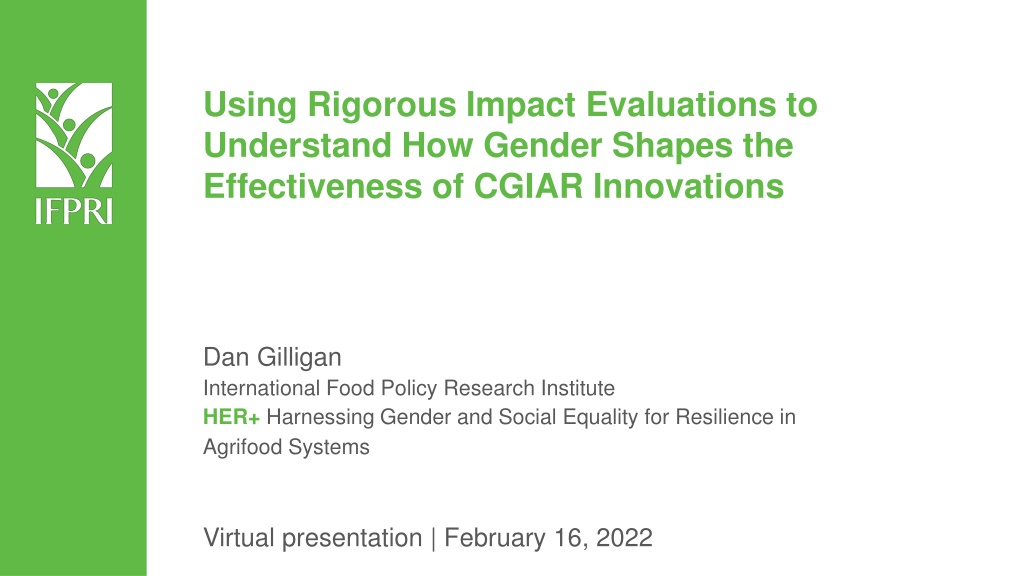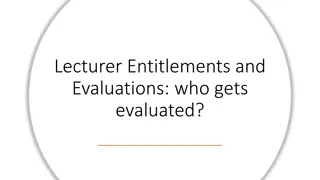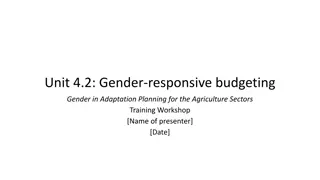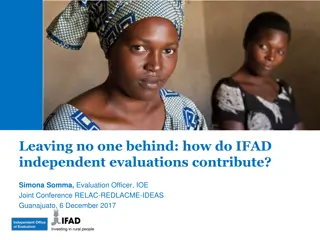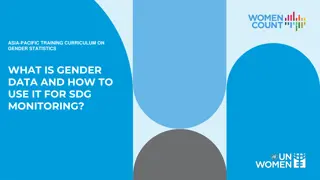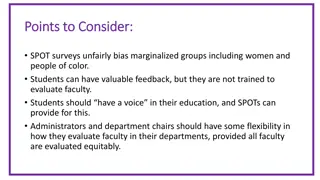Understanding Gender Impacts on CGIAR Innovations: Insights from Rigorous Evaluations
Restrictive social norms, gender-blind technologies, and inequalities in resources hinder women's empowerment in agrifood systems. This presentation highlights the importance of gender-inclusive research to enhance development efforts. By utilizing rigorous impact evaluations, we can identify how gender influences outcomes and accelerate progress by removing barriers to gender equality.
Download Presentation

Please find below an Image/Link to download the presentation.
The content on the website is provided AS IS for your information and personal use only. It may not be sold, licensed, or shared on other websites without obtaining consent from the author. Download presentation by click this link. If you encounter any issues during the download, it is possible that the publisher has removed the file from their server.
E N D
Presentation Transcript
Using Rigorous Impact Evaluations to Understand How Gender Shapes the Effectiveness of CGIAR Innovations Dan Gilligan International Food Policy Research Institute HER+ Harnessing Gender and Social Equality for Resilience in Agrifood Systems Virtual presentation | February 16, 2022
Key Messages Restrictive social norms, gender-blind technologies, low access to resources, and failures in policies and governance limit the livelihoods, agency and empowerment of women and their communities. The resulting gender inequality hinders development and is made worse by climate change (WEF GGGR 2021). Research designed from the beginning to understand gender dimensions of CGIAR research (on agrifood systems, value chain development, improving diets, poverty reduction and climate-change adaptation) often improves our understanding of these challenges. Gender-differentiated effects are complex and vary by context but can reveal important dimensions of solutions. There are many ways that rigorous impact evaluations designed to measure the causal effect of a program on an outcome against a counterfactual can be designed to study how gender shapes outcomes and how removing barriers to women s equality can accelerate development. I present several examples here.
Conceptual Framework and Gender Equality in Agrifood Systems (HER+) Gendered shocks and vulnerabilities Pandemic Climate change Conflict Individual 4 DIMENSIONS (IN)EQUALITY HER+: EMPOWER: Understanding how to bundle socio technical innovations to empower women as partners and drivers of CC solutions HER+: PROTECT: Gender- responsive social protection to promote for climate adaptation and resilience and equality Access to & control over resources Women s agency Formal HER+: TRANSFORM: Reducing normative constraints that limit women s economic resilience to CC challenges HER+: VOICE: Promoting Inclusive Governance and Policies for Women s Resilience to CC Gendered social norms Policies & governance Systemic Unequal responsibilities Restrictive masculinities Harmful norms Adapted from Njuki et al 2021 Structural gender inequalities FOOD SYSTEMS DRIVERS
Gender differentiated, rigorous impact evaluation designs Treatment effect heterogeneity how do impacts differ by gender? Measure intrahousehold decision-making, agency and women s empowerment in the survey instrument (use Pro-WEAI!) o Quisumbing et al. (2021). RCT: bundled ag, nutrition and gender interventions provided to men and women jointly o All interventions improved women s empowerment; nutrition training improved men s gender attitudes on women s responsibilities in childcare, cooking o Ambler et al. (2021) find differences in recall between women and men on asset ownership, decision-making; associated with worse outcomes for women Mixed method designs: combine quantitative and qualitative assessments to understand underlying mechanisms behind average treatment effects o El-Enbaby et al. (2021). Regression discontinuity design: measure impacts of cash transfers in Egypt targeted by Proxy Means Test. o transfers to women without primary education negatively impact their role in decision-making
Gender differentiated, rigorous impact evaluation designs Importance of gender in social networks and diffusion of technology o Beaman and Dillon (2017). RCT: randomized whether farmers received information about technology directly or through social networks o find that women are less likely to learn about a technology from social networks; gender differences in social learning Gender dimensions of willingness-to-pay (WTP) for information o Hidrobo et al. (2021). Randomized encouragement design: randomized promotion of a digital ag and nutrition information between men and women o women had lower WTP to than men; driven by women with other info sources Using list experiments (LE) for questions around sensitive behaviors o Gilligan et al. (2021) used LE to measure intimate partner violence (IPV) in RCT of graduation model program o found, unexpectedly, that LE appeared to increase underreporting of IPV
Example: Bargaining power, decision making, and biofortification: The role of gender in adoption of orange sweet potato in Uganda* *Joint with Neha Kumar, Scott McNiven, Agnes Quisumbing, and JV Meenakshi
Gender and Biofortification HarvestPlus promotes biofortification as a strategy to reduce malnutrition (e.g., vitamin A deficiency (VAD); iron deficiency) strategy: breed staples crops to be a rich source of missing micronutrients like iron, vitamin A, and zinc potential: sustainable in rural areas, self-targeting toward the poor, cost- effective over time Success of biofortification depends on widespread adoption and consumption of new crop varieties. Gender may be important: women provide much of the on-farm labor in Africa and elsewhere and are primarily responsible for child diets there is often a complex dynamic of intrahousehold gender relations for crop choice (von Braun, Puetz and Webb, 1989)
An Evaluation of Biofortification in Uganda HarvestPlus Orange-Fleshed Sweet Potato (OSP) Project disseminate provitamin-A-rich OSP as a strategy to increase vitamin A intakes and reduce vitamin A deficiency In 2007, 10,000 households in Uganda were given OSP vines plus agriculture, nutrition and marketing trainings in two models: Model 1: 2 years of trainings (intensive) Model 2: 1 year of trainings (less intensive) IFPRI/HarvestPlus/CIP evaluation randomized controlled trial 2007-2009-2011: baseline, endline and follow-up surveys; qual survey outcomes: OSP adoption, dietary intakes of vitamin A, serum retinol questionnaire captured gender roles in decision-making
Key Findings of the OSP Evaluation 1. OSP adoption: Project increased OSP adoption by 61 percentage points. Share of OSP in total SP area increased to 43%. 2. Dietary Intakes of vitamin A (from dietary recall modules) dietary intakes of vitamin A increased sharply for two cohorts of children (3-5 yrs, 6-35 mos) and for adult women prevalence of inadequate intakes of vitamin A fell 33 ppt for young children and 26-36 ppt for women 3. Serum retinol significant 9.5 percentage point reduction in prevalence of low serum retinol (retinol<1.05 mol/L) at endline among children with low serum retinol at baseline
Research questions on the role of gender 1. How do gender dimensions of control over land and intrahousehold decisionmaking affect OSP adoption and vitamin A intakes? 2. What is the role of women s bargaining power, measured as control over assets, in OSP adoption? 3. What is the role of gender in the effect of social networks on OSP diffusion and sustainability of OSP adoption?
Intrahousehold Crop Choice Decisions Separate plots are not always good for the well being and unity of the family. A family can only progress if there s cooperation between husband and wife. -- male FGD participant in Kamuli "Who decided what to grow on this parcel?" 0.9 0.8 0.7 0.6 Females only Males only Joint, females first Joint, males first 0.5 0.4 0.3 0.2 0.1 0 Full sample Kamuli Bukedea Mukono Women alone make the crop choice decisions for 20% of land parcels 75% of crop choice decisions are joint, but men may receive priority in as much as 80% of those decisions
Lessons about gender in OSP adoption 1. Control over assets and OSP adoption The share of land or non-land assets exclusively owned by women does not affect the household decision to grow OSP across four seasons Table 2: Household OSP adoption, controlling for women s baseline asset ownership All project households Dep. Var.: Pr(Adopt OFSP) Share of land exclusively owned by women, 2007 0.042 (0.078) Share of nonland assets exclusively owned by women, 2007 Observations Notes: RE model with controls. * significant at the 10% level; **significant at the 5% level. 0.037 (0.073) 3100
Lessons about gender in OSP adoption 2. Gender, control over land and crop choice Household crop choice decisions are complex and are usually joint decisions by men and women, but with men taking the lead. OSP adoption is most likely on plots where decisions are joint, but women play a leading role. Table 4: OSP adoption by female ownership of nonland assets Plots exclusively controlled by women are more likely to have OSP than plots exclusively controlled by a man Treated households that have adopted OSP (2) 0.018 (0.028) -0.147** (0.068) 0.040 (0.025) 2283 Treated households Dep Var: Grow OSP on this parcel Parcel control: female only (1) OSP adoption is significantly more likely on plots under joint control in which a woman is the primary decisionmaker than those under joint control but where a man leads decision- making 0.027 (0.027) -0.074 (0.054) 0.058** (0.026) 3707 Parcel control: male only Parcel control: joint, female 1st Observations Notes: Other control variables not reported.
Lessons about gender in OSP diffusion 3. Role of gender in diffusion of OSP to other households Households in which women have more bargaining power based on nonland assets (and not land assets) are more likely to share OSP vines with other households Table 8: Gender-based differences in diffusion of OSP, 2007-2009 Dep Var: Treated households shared OSP vines with other households Women s bargaining power based on control over land Women s bargaining power based on control over nonland assets (2) (1) 0.241 (0.149) 0.060 (0.059) Fraction of value of land exclusively owned by the woman in 2007 Fraction of value of land jointly owned in 2007 Fraction of value of nonland assets exclusively owned by the woman in 2007 Fraction of value of nonland assets jointly owned in 2007 0.460*** (0.144) 0.172** (0.069)
Summary and Conclusions Complex relationship between gender, control over household resources and OSP adoption and diffusion Female bargaining power (share of land and non-land assets under her exclusive control) does not unambiguously increase OSP adoption However, probability of adoption highest in parcels where there is joint decision-making on crop choice, and women take the primary decision thus trainings focused only on women may be missing opportunities. Variations by district indicate large role of gender norms and context in study area.
Suggested reading Ambler, K., C. Doss, C. Kieran, and S. Passarelli. 2021. He Says, She Says: Spousal Disagreement in Survey Measures of Bargaining Power. Economic Development and Cultural Change. Pp. 765-788. Beaman, L. and A. Dillon. 2014. Diffusion of Agricultural Technologies within Social Networks: Evidence from Composting in Mali. http://womenandclimate.ifpri.info/files/2014/09/PN_2014_GCC_04_replaced_web.pdf de Brauw, A., P. Eozenou, D.O. Gilligan, C. Hotz, N. Kumar and J.V. Meenakshi. 2018. Biofortification, Crop Adoption and Health Information: Impact Pathways in Mozambique and Uganda. American Journal of Agricultural Economics 100(3): 906-930. El-Enbaby, H., D.O. Gilligan, N. Karachiwalla, Y. Kassim and S. Kurdi.2020. Cash Transfers and Women's Control over Decision-Making and Labor Supply in Egypt. IFPRI MENA Working Paper 30. Gilligan, D.O., N. Kumar, S. McNiven, A. Quisumbing and J.V. Meenakshi. 2020. Bargaining Power, Decision Making, and Biofortification: The Role of Gender in Adoption of Orange Sweet Potato in Uganda. Food Policy 95:101909. https://doi.org/10.1016/j.foodpol.2020.101909 Gilligan, D.O., M. Hidrobo, J. Leight, H. Tambet. 2021. Using a list experiment to measure intimate partner violence: Cautionary evidence from Ethiopia. Hidrobo, M., G. Palloni, J. Aker, D.O. Gilligan, and N. Ledlie. Paying for Digital Information: Assessing Farmers Willingness to Pay for Digital Agriculture and Nutrition Service in Ghana. Forthcoming, Economic Development and Cultural Change, January 2021. Hotz, C., C. Loechl, A. Lubowa, J.K. Tumwine, G. Ndeezi, A.N. Masawi, R. Baingana, A. Carriquiry, A. Brauw, J.V. Meenaksi, and D.O. Gilligan. 2012a. Introduction of -carotene rich orange sweet potato in rural Uganda resulted in increased vitamin A intakes among children and women and improved vitamin A status among children. Journal of Nutrition 142(10): 1871-1880. Njuki, J., S. Eissler, H.J. Malapit, R.S. Meinzen-Dick, E. Bryan, and A.R. Quisumbing.2021. A review of evidence on gender equality, women s empowerment, and agrifood systems. United Nations Food Systems Summit. https://dx.doi.org/10.48565/scfss2021-1q69 Quisumbing, A., A. Ahmed, J. Hoddinott, A. Pereira and S. Roy. 2021. Designing for empowerment impact in agricultural development projects: Experimental evidence from the Agriculture, Nutrition, and Gender Linkages (ANGeL) project in Bangladesh. World Development 146: 105622. World Economic Forum.Global Gender Gap Report, 2021. https://www3.weforum.org/docs/WEF_GGGR_2021.pdf
